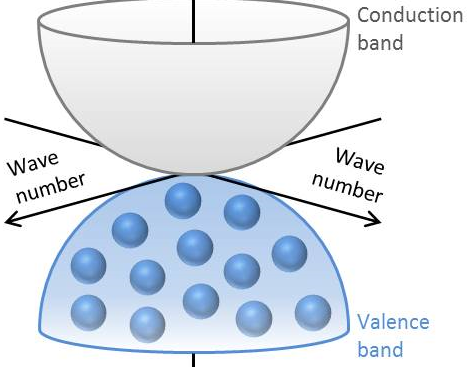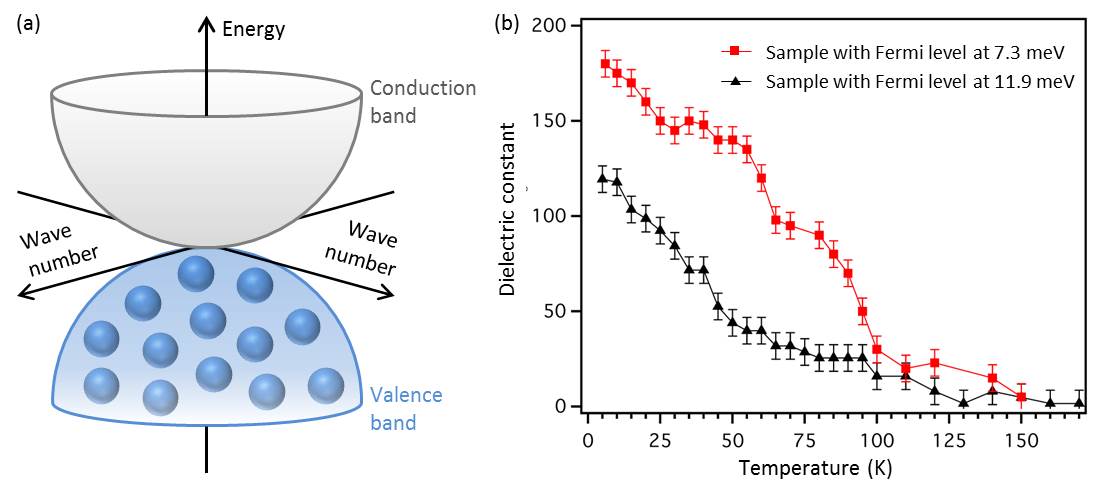Discovery of zero-gap semiconductor with strong electronic correlations The finding casts light on a 40-year-old solid state physics enigma


(a) depicts the band structure of a Luttinger semimetal, one of the zero-gap semiconductors. The valence band, filled with electrons (blue balls), and the empty conduction band have a three-dimensional parabolic shape and are in contact with each other at a single point at the Fermi level. (b) shows the temperature dependence of the dielectric constant. The value is several dozens of times larger than that of known zero-gap semiconductors (e.g. alpha tin and mercury tellluride) at low temperatures. The smaller the Fermi level measured from the energy where the valence and conduction bands are in contact, the larger the dielectric constant is at low temperature.
© 2018 Takumi Ohtsuki.
Researchers at the University of Tokyo and their collaborators at Johns Hopkins University in the U.S. performed terahertz spectroscopy measurements on iridate (Pr2Ir2O7) known as a zero-gap semiconductor. At 5 kelvins (minus 268 degrees Celsius), they observed a large dielectric constant of about 180. This is several orders of magnitude greater than that of other zero-gap semiconductors. This demonstrates that the electronic correlation in this material is very strong.
Zero-gap semiconductors are fascinating because of topological functionalities such as high mobility and the quantum Hall effect. More than 40 years ago, scientists predicted that materials in a Luttinger semimetal state with touching quadratic bands would show novel electronic states due to strong electronic correlation, something unobtainable in conventional metals. However, clarifying the effects of electronic correlation experimentally in known semimetals such as alpha tin and mercury telluride has been difficult since the effective mass of electrons is small, amounting to only a weak electronic correlation.
To clarify the effect of the strong electronic correlation, the research group led by Professor Satoru Nakatsuji and Professor Mikk Lippmaa at the Institute for Solid State Physics at the University of Tokyo studied Pr2Ir2O7, which has a large effective mass. Earlier studies had shown that Pr2Ir2O7 is a Luttinger semimetal with quadratic band touching and that the effective mass is about six times heavier than free electrons in a vacuum. Additionally, in such systems, the dielectric constant is a measure of the scale of the electronic correlation. The research group carried out terahertz spectroscopy on Pr2Ir2O7, and observed a very large dielectric constant of about 180 at a low temperature of 5 kelvins. This value revealed that the scale of the correlation is about two orders of magnitude larger than the kinetic energy.
Thus, the research group demonstrated that the electronic correlation is very strong in Luttinger semimetals with quadratic band touching among the zero-gap semiconductors. Scientists expect that in the future, further understanding of the role of the electronic correlation in determining the physical properties of zero-gap semiconductors will lead to the creation of novel metallic states with new functionalities.
“Although a strong electronic correlation in Luttinger semimetals was predicted over 40 years ago, it was unverified. But this time it was clearly demonstrated experimentally,” says Nakatsuji. He continues, “Zero-gap semiconductors with strong electronic correlation are still undeveloped. In the future, we would like to form a deeper understanding of the role of the electronic correlation, and create novel electronic states and functionalities that are unobtainable in conventional materials.”
This study was supported by the Strategic Basic Research Programs (CREST) of the Japan Science and Technology Agency (JST) as a project covering “From understanding of topological electronic structure toward development of basic technology for energy harvesting” in the research area “Scientific Innovation for Energy Harvesting Technology,” by Grants-in-Aid for Scientific Research and Program for Advancing Strategic International Networks to Accelerate the Circulation of Talented Researchers from the Japanese Society for the Promotion of Science (JSPS), and by Grants-in-Aid for Scientific Research on Innovative Areas “J-Physics” from the Ministry of Education, Culture, Sports, Science and Technology of Japan.
Papers
Bing Cheng, Takumi Ohtsuki, Dipanjan Chaudhuri, Satoru Nakatsuji, Mikk Lippmaa and N. Peter Armitage, "Dielectric anomalies and interactions in the three-dimensional quadratic band touching Luttinger semimetal Pr2Ir2O7," Nature Communications: December 13, 2017, doi:10.1038/s41467-017-02121-y.
Link (Publication )
)
Related links
- Institute for Solid State Physics

- Quantum Materials Group, Institute for Solid State Physics

- Nakatsuji Laboratory, Quantum Materials Group, Institute for Solid State Physics






